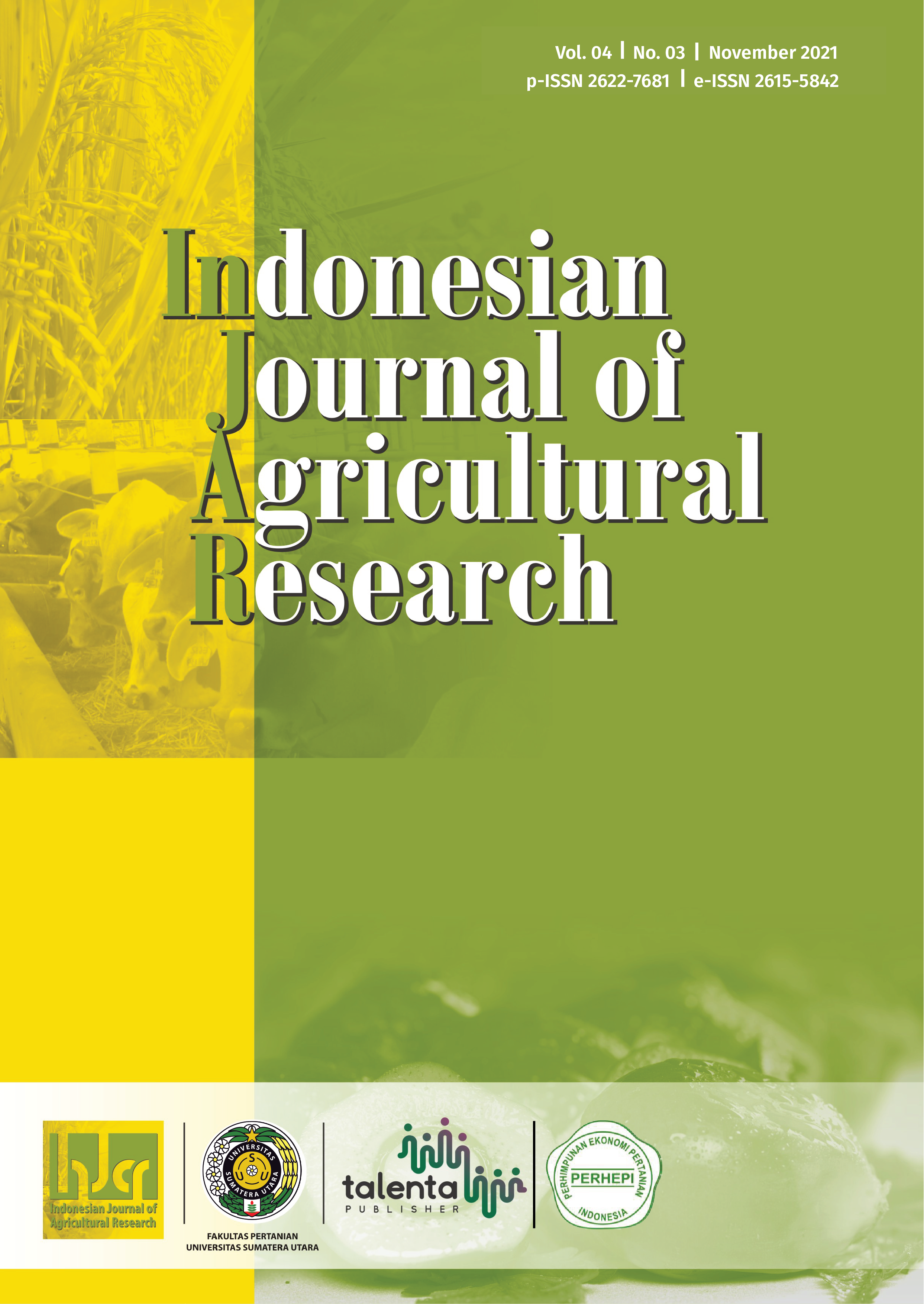In Vitro Evaluation of Fungicides against Fusarium solani, the Causative Agent of Brinjal Root Rot
DOI:
https://doi.org/10.32734/injar.v4i3.6275Keywords:
brinjal, fungicides, fusarium, pathogen, root rotAbstract
Root rot in brinjal is one of the most important problems. In the present research, five different fungicides; Mancozeb, Copper oxychloride, Hexaconazole, Metalaxyl+Mancozeb, and Carbendazim, at 100 ppm were evaluated for their efficacy against the causative agent of this disease, Fusarium solani, In-vitro. The experiment was carried out in Completely Randomized Design with seven replications. Our result shows the difference in the efficacy of all tested fungicide against this pathogen. The application of Carbendazim at 100 ppm gave the highest inhibition of mycelium growth (100%) followed by Mancozeb (85.08%) and Metalaxyl+Mancozeb (64.3%) (at the same dose) on the 7th day of incubation suggesting Carbendazim (100 ppm) as a better one to use for the management of F. solani.
Downloads
References
MOAD, "Statistical Information on Nepalese Agriculture 2018/19". pp.1–437, 2020. https://www.moald.gov.np/
J. M. Vincent, "Distortion of fungal hyphae in the presence of certain inhibitors," Nature, vol.159, no.4051, pp.850- 850, 1947.
Y. Zhou, J. Xu, Y. Zhu, Y. Duan, and M. Zhou, "Mechanism of action of benzimidazole fungicide on fusariumgraminearum: Interfering with polymerization of monomeric tubulin but not polymerized microtubule," Disease Control and Pest Management, vol. 106, no. 8, pp. 807-813, 2016. DOI: https://doi.org/10.1094/PHYTO-08-15-0186-R
L.C. Davidse, "Antimitotic activity of methyl benzimidazol-2-yl carbamate (MBC) in Aspergillus nidulans," Pesticide Biochemistry and Physiology, vol. 3, no. 3, pp. 317–325, 1973. DOI: https://doi.org/10.1016/0048-3575(73)90030-8
R. S. Hammerschlag, and H.D. Sisler, "Benomyl and methyl-2-benzimidazolecarbamate (MBC): Biochemical, cytological and chemical aspects of toxicity to Ustilago maydis and Saccharomyces cerevesiae," Pesticide Biochemistry and Physiology, vol. 3, no. 1. pp. 42–54, 1973. DOI: https://doi.org/10.1016/0048-3575(73)90007-2
S. L.Yadav, R. R. Ahir, B. S. Rathore, and S. M. Yadav, "Efficacy of different fungicides and organic amendments against basal rot of onion caused by fusarium oxysporum in vitro," Plant Pathology Journal, vol. 13, no. 1, pp. 56–58, 2014. DOI: https://doi.org/10.3923/ppj.2014.56.58
K. K. Soni and R. K. Verma, "A new vascular wilt disease of amla (Emblica officinalis) and its management," Journal of Mycology and Plant Pathology, vol.40, no. 2, pp. 187-191, 2010.
Taskeen-Un-Nisa, A. H. Wani, M. Y. Bhat, S. A. Pala, and R. A. Mir, "In vitro inhibitory effect of fungicides and botanicals on mycelial growth and spore germination of fusarium oxysporum," Journal of Biopesticides, vol. 4, no. 1, pp. 53–56, 2011.
M. Chennakesavulu, M. Reddikumar, N. P. E. Reddy, P. Pathology, S.V. A.College, and T. Regional, "Evaluation of Different Fungicides and their Compatibility with Pseudomonas fluorescens in the Control of Redgram Wilt Incited by Fusarium udum," Journal of Biological Control, vol. 27, no. 4, pp. 354–361, 2013. DOI: https://doi.org/10.18311/jbc/2013/3272
A. R. Dibya Bharati, "In-vitro efficacy of different fungicides against pathogens causing wilt of betelvine," International Journal of Pure & Applied Bioscience, vol. 6, no. 2, pp. 187–192, 2018. DOI: https://doi.org/10.18782/2320-7051.5075
K. Khilari, S. K. Jain, and P. Mishra, "In vitro evaluation of different fungicides against fusarium moniliforme - causing bakanae disease of rice," International Journal of Chemical Studies, vol.7, no. 3, pp. 1672–1677, 2019.
N. I. Singh, R. K. T. Devi, and P. P. Devi, "Effect of fungicides on growth and sporulation of Fusarium solan", Indian Phytopathology, vol. 53, no. 3, pp. 327-328, 2000.
T. W. Allen, S. A. Enebak, and W. A. Carey, “Evaluation of fungicides for control of species of Fusarium on longleaf pine seed,†Crop Protection, vol. 23, no. 10, pp. 979–982, 2004. DOI: https://doi.org/10.1016/j.cropro.2004.02.010
A. Baturo-Ciesniewska, L. Lenc, A. Grabowski, and A. Lukanowski, "Characteristics of Polish Isolates of Fusarium sambucinum: Molecular Identification, Pathogenicity, Diversity and Reaction to Control Agents," American Journal of Potato Research, vol. 92, no. 1, pp. 49–61, 2015. DOI: https://doi.org/10.1007/s12230-014-9410-z
N. M. J. A. Abu-Mejdad, "Response of some fungal species to the effect of copper, magnesium and zinc under the laboratory condition," European Journal of Experimental Biology, vol. 3, no. 2, pp. 535–540, 2013.
M. A. C. Luna, E. R. Vieira, K. Okada, G. M. Campos-Takaki, and A. E. do Nascimento, "Copper-induced adaptation, oxidative stress and its tolerance in Aspergillus niger UCP1261," Electronic Journal of Biotechnology, vol. 18, no. 6, pp. 418–427, 2015. DOI: https://doi.org/10.1016/j.ejbt.2015.09.006
C. Bhaliya and K. Jadeja, "Efficacy of different fungicides against Fusarium solani causing Copper-induced adaptation, oxidative stress and its tolerance in Aspergillus niger UCP1261coriander root rot," The Bioscan, vol.9, no. 3., pp. 1225–1227, 2014.
Mannai, S., N. Horrigue-Raouani, and N. M’Hamdi, "Effect of Six Fungicides against Fusarium oxysporum and F. solani Associated with Peach Seedlings Decline in Tunisian Nurseries," Annual Research and Review in Biology, vol. 26, no. 4., pp. 1–11, 2018. DOI: https://doi.org/10.9734/ARRB/2018/41295
Downloads
Published
How to Cite
Issue
Section
License
Copyright (c) 2022 Indonesian Journal of Agricultural Research

This work is licensed under a Creative Commons Attribution-ShareAlike 4.0 International License.



















